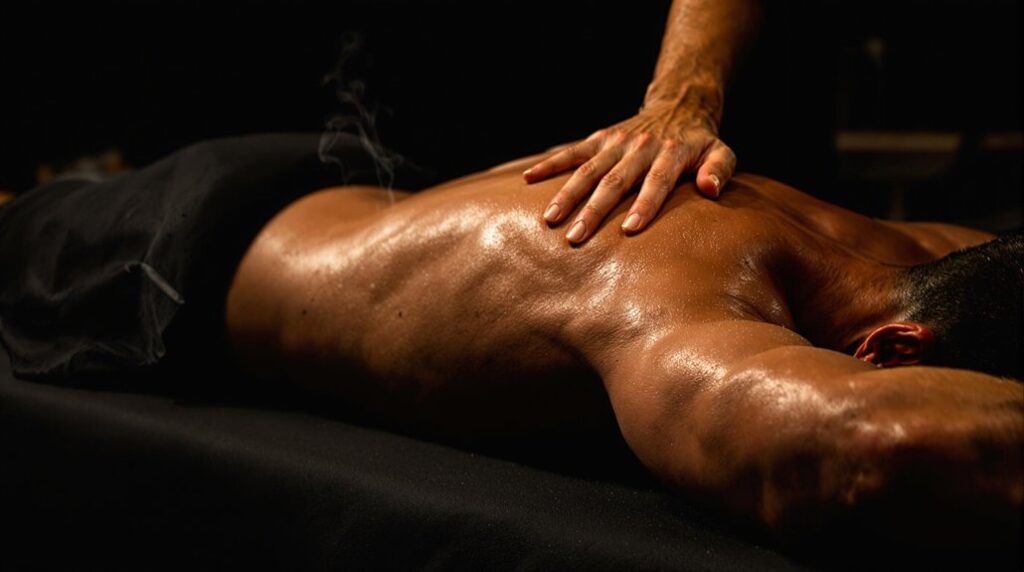Deep tissue massage can greatly boost your athletic performance and recovery through multiple mechanisms. You'll experience enhanced muscle repair, reduced inflammation, and improved blood flow to damaged tissues. The therapy breaks down adhesions, increases range of motion, and helps prevent sports-related injuries by maintaining proper muscle function. Beyond physical benefits, you'll gain mental advantages like reduced anxiety and better sleep quality. Understanding these benefits reveals why elite athletes consistently incorporate this therapy into their training regimens.
Understanding Deep Tissue Massage in Sports
While many athletes focus primarily on training and nutrition, deep tissue massage has emerged as an essential component in sports performance and recovery. You'll find that this specialized technique targets your body's deeper muscle layers and connective tissues, applying concentrated pressure to break down adhesions and scar tissue that can limit your range of motion.
Unlike regular massage, deep tissue work isn't just about relaxation – it's a therapeutic approach that's specifically designed to address athletic concerns. When you're training intensively, you'll develop micro-tears and tension in your muscles that can affect your performance. Through strategic manipulation of your soft tissues, deep tissue massage helps realign muscle fibers, increase blood flow to affected areas, and reduce inflammation that often results from intense physical activity. Additionally, sports massage serves as an effective tool for maximizing movement and lowering pain, further enhancing your recovery process.
Enhanced Recovery and Muscle Repair
When athletes engage in rigorous training sessions, their muscles experience microscopic damage that requires proper recovery time and therapeutic intervention. Deep tissue massage can greatly accelerate your recovery by increasing blood flow to damaged muscle fibers and reducing inflammation in affected areas.
You'll notice that this targeted pressure helps break down adhesions and scar tissue, while simultaneously stimulating the production of mitochondria in your muscle cells. The massage's mechanical action on your soft tissues triggers the release of cytokines and growth factors, which play vital roles in muscle repair and adaptation. Additionally, you'll benefit from increased oxygen delivery to recovering muscles, as the massage helps dilate blood vessels and improve circulation throughout the treated areas, ultimately supporting faster healing and enhanced athletic performance. This technique is especially beneficial for athletes looking to enhance their injury resilience and performance through effective recovery strategies.
Prevention of Sports-Related Injuries
Through regular deep tissue massage sessions, athletes can considerably reduce their risk of common sports injuries by addressing muscular imbalances and tension patterns before they develop into serious problems. You'll find that deep tissue massage breaks down adhesions and scar tissue that can restrict your range of motion and lead to compensatory movement patterns. This preventive approach helps identify tight spots and potential problem areas before they escalate into strains or tears.
When you maintain proper muscle length-tension relationships through massage, you're less likely to experience overuse injuries that often result from repetitive motions in your sport. Deep tissue work also improves your body's proprioception, helping you maintain better form during training and competition, which is essential for preventing acute injuries and joint stress. Additionally, regular massage can aid in muscle tear recovery by promoting blood flow and reducing inflammation, further enhancing athletic performance.
Improved Range of Motion and Flexibility
As your muscles and connective tissues respond to deep tissue massage techniques, you'll experience a significant increase in your range of motion and overall flexibility. You'll notice improvements in joint mobility and muscle elasticity, which directly enhance your athletic performance and reduce your risk of strain during training.
| Body Area | Benefits of Improved ROM |
|---|---|
| Shoulders | Enhanced throwing power and swim strokes |
| Hips | Better running stride and jumping ability |
| Back | Increased rotational movements and core stability |
| Legs | Superior kick mechanics and sprint performance |
| Neck | Improved head mobility and reaction time |
Regular deep tissue massage sessions will help you maintain these flexibility gains, and you'll find that your body adapts more efficiently to intense training demands. The increased pliability of your soft tissues will allow you to achieve peak form during complex athletic movements.
Mental and Physical Performance Benefits
While deep tissue massage delivers numerous physical advantages, its impact on mental clarity and athletic performance creates a powerful synergy that can elevate your competitive edge. You'll experience enhanced focus and reduced anxiety before competitions, as the massage triggers the release of endorphins and decreases cortisol levels. The treatment also improves your sleep quality, which directly affects your reaction time and decision-making abilities during critical moments.
On the physical side, you'll notice improved muscle recruitment patterns and better neuromuscular coordination, leading to more efficient movement execution. The increased blood flow and reduced muscle tension will help you maintain peak performance for longer periods, while the enhanced recovery between training sessions allows you to maintain a more intensive training schedule without risking overtraining or burnout.
When and How Often Athletes Should Get Treatment
Three key factors determine the ideal timing and frequency of deep tissue massage treatments for athletes: training intensity, competition schedule, and recovery needs.
You'll want to schedule your treatments 3-5 days before competition to maintain peak performance while avoiding post-massage soreness. During regular training periods, you should aim for sessions every 1-2 weeks, adjusting based on your workout intensity and recovery patterns. If you're training heavily, you might need treatments twice weekly, while light training may only require monthly sessions. When recovering from an injury, you'll benefit from more frequent treatments initially, tapering off as healing progresses. It's crucial to communicate with your massage therapist about your training schedule and any upcoming events to optimize the timing of your sessions.

